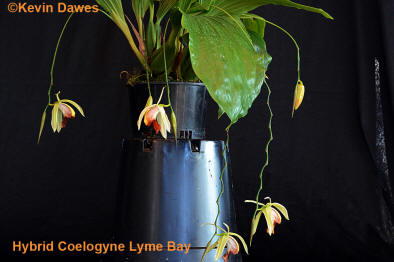This
hybrid was pollinated 15th July 2013 by using Coelogyne Memoria
Wilhelm Micholitz as the pod parent and Coelogyne Lyme Bay as the pollen
parent. It was flasked on 12th September 2014 and deflasked 12
month later. It flowered for the first time on 10th April
2019.
As this
hybrid contains the combined genes of four parents in its background, this
hybrid will represent the first complex Coelogyne hybrid to be officially
registered. Its production could introduce much more complicated breeding
programs in the future. Managing constructive and positive Coelogyne
development could become less predictable and there will need to be more
rigorous recording of both parentage and results. Growers are urgently
encouraged to support the registration and databases maintained by the RHS
to avoid the undocumented chaos that some growers have created with other
orchid genera in the past.
This
particular hybrid is very attractive with a large flower 110mm across and
has potential as a future parent for further development. It is very similar
to and shares three of the same parents as Coelogyne Kirribilli Colin
(hybrid Coelogyne Mem Wilhelm Micholitz x Coelogyne usitana) and the
Coelogyne usitana component from the pollen parent, Coelogyne Lyme Bay
(Coelogyne usitana x Coelogyne speciosa).
Coelogyne Mem Wilhelm Micholitz x Coelogyne Lyme Bay is more open than
Coelogyne Kirribilli Colin. The sepals and petals have a distinct pale green
colouring. It is very difficult to observe the genetic influence from the
only other ancestor, Coelogyne speciosa.
The
psuedobulbs are broad at the base - 50mm – tapering quickly to two leaves
after 80mm and slightly quadrangular, very close together forming a compact
plant with very short internodes.
The
leaves are broad 90 -110mm wide and around 300mm long with many prominent
veins.
The
peduncle protrudes from the developing psuedobulb (i.e. synanthous) around
120mm in a semi-pendulous fashion so that the flowers are produced at or
below the rim of the pot and basically facing downwards.
The
flowers open in close succession with each flower lasting about three weeks
and only two open at any one time. The sepals are 50mm x 20mm, quite open
and displaying a very distinctive mid-rib. Both sepals and petals are pale
coloured white with very strong green tonings, especially obvious in the
mid-rib. The petals are 40mm x 10mm and protrude at an angle around 90
degrees giving the flower a very open character.
The
tube of the flower is 50mm from base to the tip of the lip and only around
20mm across. The tube is very dominated by a dark chocolate colouring that
envelops both inside and outside of the lobes and extends well out towards
the lip. It fades into an off-white, slightly vague slightly rounded tip.
Underneath the tube an off-white patch extends from the base, narrows
towards the end of the lobes and widens again under the tip.
The
prominent column, 35mm x 10mm, is a pale lemon/green colour developing into
a much darker mustard tip. The column lies fairly flat and is partly
enclosed by the side lobes. This gives the impression of a more tubular
flower. The bracts are deciduous.
Two low
distinctive keels extend from the base to well out onto the lip. A middle
keel also the same dark colour as the tube, starts at the base of the flower
and only extends to the middle of the side lobes.
On the
rear part of the outside lobes there is some clear paler colouring showing
distinct veins extending from the base to about one third the way towards
the tip.
As the
flower ages the dark chocolate colourings fade to a light tobacco tone and
the whole colouring of the flower is much lighter.
Rating: ♦♦♦
Registration: Registration with the RHS as Coelogyne Kirribilli Joseph Feld was recorded in May 2019. It has been named after my son-in-law, Joseph Feld.
Varieties: None known.
Hybrids: None registered
| < Coel Kirribilli Jimmy | Coel Kirribilli John Davies > |


